RBSE Solutions for Class 10 Science Chapter 3 Genetics are part of RBSE Solutions for Class 10 Science. Here we have given Rajasthan Board RBSE Class 10 Science Solutions Chapter 3 Genetics.
| Board | RBSE |
| Textbook | SIERT, Rajasthan |
| Class | Class 10 |
| Subject | Science |
| Chapter | Chapter 3 |
| Chapter Name | Genetics |
| Number of Questions Solved | 63 |
| Category | RBSE Solutions |
Rajasthan Board RBSE Class 10 Science Solutions Chapter 3 Genetics
Textbook Questions Solved
I. Multiple Choice Questions
RBSE Solutions For Class 10 Science Chapter 3 Question 1:
Who coined the (RBSESolutions.com) term ‘genetics’?
(a) Mendel
(b) Bateson
(c) Morgan
(d) Punette
Answer:
(b) Bateson
RBSE Class 10 Science Chapter 3 Question 2:
Mendel conducted his experiments on which of the following?
(a) Sweet pea
(b) Wild pea
(c) Garden pea
(d) All of these
Answer:
(c) Garden pea
Chapter 3 Class 10 Science RBSE Question 3:
What is the name of the branch of science (RBSESolutions.com) which deals with heredity and variations?
(a) Heredity
(b) Geology
(c) Forestry
(d) None of the above
Answer:
(a) Heredity
RBSE Class 10th Science Chapter 3 Question 4:
The green colour of pea pod is which type of character?
(a) Dominant
(b) Recessive
(c) Partially dominant
(d) Co-dominant
Answer:
(a) Dominant
Class 10 Science Chapter 3 RBSE Question 5:
A gene generally has how (RBSESolutions.com) many alleles?
(a) Four
(b) Three
(c) Two
(d) One
Answer:
(c) Two
RBSE Solutions For Class 10 Science Question 6:
Mendel selected how many inheritable pairs of traits for his experiments?
(a) 34
(b) 2
(c) 12
(d) 7
Answer:
(d) 7
RBSE Class 10 Science Chapter 3 Genetics Question 7:
Which term is used for cross of any one (RBSESolutions.com) parent with F1 generation?
(a) Reciprocal cross
(b) Test cross
(c) Back cross
(d) All of these
Answer:
(c) Back cross
RBSE Class 10 Science Chapter 3 Question Answer Question 8:
What will be the ratio of progenies after crossing Tt x tt?
(a) 3: 1
(b) 1: 1
(c) 1 : 2 : 1
(d) 2 : 1
Answer:
(b) 1 : 1
RBSE Solution Class 10 Science Chapter 3 Question 9:
Which of the following inheritable traits was not (RBSESolutions.com) selected by Mendel for his experiments?
(a) Colour of roots
(b) Colour of flowers
(c) Colour of seeds
(d) Colour of pods
Answer:
(a) Colour of roots
RBSE Class 10 Chapter 3 Science Question 10:
How many genotypes are formed in F2 generation after monohybrid cross?
(a) 2
(b) 3
(c) 4
(d) 9
Answer:
(b) 3
Genetics Very Short Answer Type Questions
RBSE Solutions Class 10 Science Question 11:
Who is called as father of genetics?
Answer:
Mendel
RBSE Solution For Class 10th Science Question 12:
Mendel conducted his experiments on (RBSESolutions.com) which plants?
Answer:
Pea
Genetics Class 10 RBSE Question 13:
What is a dominant trait?
Answer:
A trait which expresses itself in F1 generation is called the dominant trait.
RBSE Solution Class 10 Science Question 14:
Which term is used for transfer of genetic traits (RBSESolutions.com) from one generation to next generation?
Answer:
Inheritance
RBSE Solutions For Class 10 Social Science Chapter 3 Question 15:
Who rediscovered the Mendel’s laws?
Answer:
Hugo de Vries, Carl Correns and Erick von Tschermak
RBSE Solutions Science Class 10 Question 16:
What is the full name of Mendel?
Answer:
Gregor John Mendel
RBSE Class 10 Science Chapter 3 Notes Question 17:
Write the names of laws proposed by (RBSESolutions.com) Mendel.
Answer:
Ans. Following laws were proposed by Mendel:
- Law of dominance
- Law of segregation
- Law of independent assortment
Science Class 10 Chapter 3 Question 18:
What is test cross?
Answer:
When F1 generation is crossed with parent with recessive traits, it is called a test cross.
Www.RBSEsolutions.Com Class 10 Question 19:
What do you understand (RBSESolutions.com) by out cross?
Answer:
When F1 generation is crossed with its parent’s generation with dominant traits it is called out cross.
RBSE Solution Class 10th Science Question 20:
Which law of Mendel cannot be explained by monohybrid cross?
Answer:
Law of independent assortment
Genetics Short Answer Type Questions
RBSE Solutions For Class 10th Science Question 21:
What is the difference between phenotype (RBSESolutions.com) and genotype?
Answer:
The set of observable traits is called phenotype, while the genetic constitution is called genotype. Two plants with the same phenotype may have different genotype.
RBSE Solution 10th Class Science Question 22:
Briefly explain dihybrid cross.
Answer:
When two pairs of contrasting traits are studied in a cross, it is called dihybrid cross. For example; when a pea plant is studied for its flower’s colour and pod colour it is a dihybrid cross.
RBSE Solutions Of Class 10 Science Question 23:
What were the reasons for success of Mendel?
Answer:
Following are the reasons for success of Mendel:
- Mendel studied only one set of character at a time.
- Mendel carries out careful statistical analysis of his findings.
- He carefully selected a plant for study.
Class 10 RBSE Solutions Science Question 24:
Why did Mendel select pea plant for his (RBSESolutions.com) experiments?
Answer:
Mendel selected pea plants for his experiments due to following reasons:
- Pea is an annual plant and hence many generations can be studied in a short duration.
- Pea produces bisexual flowers and hence pure line of homozygous plant can be obtained by self pollination.
- Pea plant can be easily subjected to cross pollination by emasculation.
- Pea plant shows many pairs of contrasting characters which are inheritable.
RBSE Solution For Class 10 Science Question 25:
Write a brief biography of Mendel.
Answer:
Mendel was bom on 22nd July 1822 in Silision village of Heizendarf province in Austria. After taking a degree in philosophy (1842), he joined as a priest in a church at Brunn in Austria. He began his study on garden pea in church’s garden and continued his studies for seven years.
He presented his findings in the form of research paper in front of Brunn Society of Natural History. His paper was published in the annual magazine of the society.
RBSE Solution Science Class 10 Question 26:
Explain the Law of Dominance as proposed (RBSESolutions.com) by Mendel.
Answer:
When a pair of contrasting characters is crossed then only one of the characters is expressed in Fj generation. This is called law of dominance.
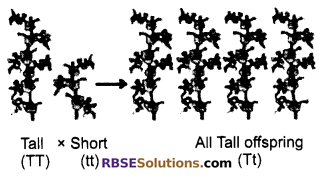
For example; when a homozygous tall plant (TT) is crossed with a homozygous short plant (tt), then all the plants of F1 generation are tall (Tt) because tallness is the dominant character.
Science Class 10 RBSE Solutions Question 27:
Write the significance of Mendel’s Laws (RBSESolutions.com) of Inheritance.
Answer:
Significance of Mendel’s Laws of Inheritance:
- The presence of dominance of a particular trait ensures that harmful traits are suppressed through generations.
- Law of independent assortment confirms the gene concept.
- Appearance of new traits can be easily explained with these laws.
- Traits can be carefully selected for producing new varieties of plants with desirable characters.
Genetics Long Answer Type Questions
RBSE Solutions Of Class 10th Science Question 28:
Explain Mendel’s Law of Segregation with (RBSESolutions.com) suitable example.
Answer:
Law of Segregation: This is also known as law of purity of gametes. As per this law, during the gametogeneis of heterozygous plant, each gene of a pair of allele goes to different gametes. Because of segregation of genes of a pair of alleles, it is called the law of segregation.
Example: When a homozygous tall plant (TT) is crosses with a homozygous short plant (tt), all the plants of F1 generation are tall plants (Tt) but heterozygous. But during the combination of genes in F1 generation, one gene does not pollute another gene and each gene maintains its purity. Due to this, when plants of F1 generation are allowed to produce the next generation, the recessive character, i.e. shortness expresses itself. This can be shown by the given diagram:
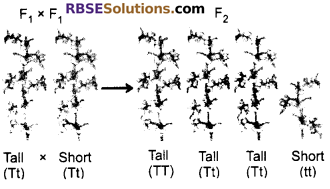
In the F2 generation, the ratio of tall plants to short plants is 3 : 1 and ratio of pure tall plants, impure tall plants and pure short plants is 1 : 2 : 1. A character which does not appear in the F1 generation is able to express itself in the F2 generation because it obeys the law of segregation.
RBSE Solution Of Class 10th Science Question 29:
What is Mendelism? Explain the law of independent (RBSESolutions.com) assortment.
Answer:
The Laws of inheritance were derived on the basis of finding by Mendel. These laws are collectively called Mendelism.
Law of Independent Assortment: When plants with two or more than two characters are crossed then expression of one character does not affect the expression of another character. Genes from a pair of alleles segregate and are free to combine with any other gene from any other pair of alleles. This is called law of independent assortment.
Example: Let us take example of dihybrid cross between a plant with round and green seeds (RRyy) and another plant with wrinkled and yellow seeds (rrYY). Here roundness or smoothness of seeds and yellow colour are dominant traits, while wrinkles on seeds and green colour are recessive traits.
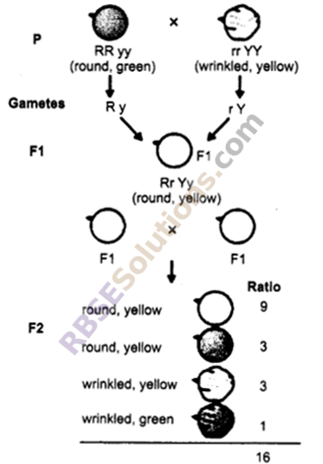
When these plants were crossed then all plants in F1 generation produced round and yellow seeds. When plants of F1 generation were allowed to reproduce, plants of F2 generation showed following traits in respective ratio:
Round yellow : Round green : Wrinkled yellow : Wrinkled green
9 : 3 : 3 :1
The observation that roundness combines with either of the colours and roughness combines with either of the colours proves the law of independent assortment.
RBSE Solutions For Class 10 Science Chapter 3 Question 30:
Explain Mendel’s Laws of (RBSESolutions.com) Inheritance.
Answer:
Following are Mendel’s Laws of Inheritance:
Law of Dominance: When a pair of contrasting characters is crossed then only one of the characters is expressed in F1 generation. This is called law of dominance. For example, when a homozygous tall plant (TT) is crossed with a homozygous short plant (tt), then all the plants of F1generation are tall (Tt) because tallness is the dominant character.
Law of Segregation: This is also known as law of purity of gametes. As per this law, during the gametogeneis of heterozygous plant, each gene of a pair of allele goes to different gametes. Because of segregation of genes of a pair of alleles, it is called the law of segregation.
For example, when a homozygous tall plant (TT) is crosses with a homozygous short plant (tt), all the plants of F1 generation are tall plants (Tt) but heterozygous. But during the combination of genes in F1 generation, one gene does not pollute another gene and each gene maintains its purity. Due to this, when plants of F1 generation are allowed to produce the next generation, the recessive character, i.e. shortness expresses itself.
Law of Independent Assortment: When plants with two or more than two characters are crossed then expression of one character does not affect the expression of another character. Genes from a pair of alleles segregate and are free to combine with any other gene from any other pair of alleles. This is called law of independent assortment.
Genetics Additional Questions Solved
I. Multiple Choice Questions
RBSE Solution Of Class 10 Science Question 1:
Which of the following is a totally impossible (RBSESolutions.com) outcome of Mendel’s Experiment (cross breeding pure bred tall and short pea plants)
(a) 3 tall 1 short plant
(b) 24 tall and 8 short plants
(c) 8 tall and 0 short plants
(d) 4 tall plants and 1 medium-height plant.
Answer:
(d) 4 tall plants and 1 medium-height plant.
Class 10th RBSE Solution Science Question 2:
Among the following which is not one of the direct conclusions that can be drawn from Mendel’s experiment?
(a) Only one parental trait is expressed in F1 generation.
(b) Two copies of each trait is inherited in sexually reproducing orgainsm
(c) For recessive trait to be expressed, both copies should be identical.
(d) Natural selection can alter frequency of an inherited trait.
Answer:
(d) Natural selection can alter frequency of an inherited trait.
Class 10 Science RBSE Solution Question 3:
Which one is a possible progeny in F2 generation of (RBSESolutions.com) pure bred tall plant with round seed and short plant with wrinkled seeds?
(a) Tall plant with round seeds
(b) Tall plant with wrinkled seeds
(c) Short plant with round seed
(d) All of the above
Answer:
(d) All of the above
Genetics Class 10 RBSE Notes Question 4:
Which of the following shows homozygous genotype?
(a) TT
(b) Tt
(c) Rr
(d) Yy
Answer:
(a) TT
Chapter 3 Science Class 10 Question 5:
Which trait will contrast with green colour?
(a) Tall plant
(b) Yellow colour
(c) Round seed
(d) Wrinkled seed
Answer:
(b) Yellow colour
RBSE Solutions Class 10th Science Question 6:
How many pairs of contrasting (RBSESolutions.com) traits are studied in trihybrid cross?
(a) One
(b) Two
(c) Three
(d) Six
Answer:
(c) Three
Class 10 RBSE Solution Science Question 7:
After monohybrid cross, what is the phenotypic ratio in F2 generation?
(a) 3:1
(b) 1:2:1
(c) 1:3:1
(d) 3:2:1
Answer:
(a) 3 :1
10th Class RBSE Solution Science Question 8:
After monohybrid cross, what is (RBSESolutions.com) the genotypic ratio in F2 generation?
(a) 3:1
(b) 1:2:1
(c) 1 : 3 :1
(d) 3:2:1
Answer:
(b) 1:2:1
Genetics Very Short Answer Type Questions
Science Chapter 3 Class 10 Question 1:
Define heredity.
Answer:
Heredity deals with the inheritance of characters from one generation to the next.
Chapter 3 Of Science Class 10 Question 2:
Define variations.
Answer:
Variations are differences that occur between (RBSESolutions.com) the organisms of the same species in spite of the same basic feature.
RBSE Solutions For Class 10 Science Hindi Medium Question 3:
What is a trait?
Answer:
A characteristics feature is called a trait.
Class 10 Science Chapter 3 Solutions Question 4:
Name two human traits that show variations.
Answer:
Colours of eyes and shape of external ears.
RBSE Solutions 10 Science Question 5:
What is a gene?
Answer:
Gene is the unit of inheritance. It is a part (RBSESolutions.com) of the chromosome which controls the appearance of a set of hereditary characteristics.
Class 10 Science Chapter 3 Question Answer Question 6:
What is genetics?
Answer:
The branch of biology in which we study about heredity and variations in living beings is called genetics.
RBSE Science Class 10 Chapter 3 Question 7:
What are hereditary traits?
Answer:
Traits which are transmitted from one generation to another are called hereditary traits.
10th Class Science Chapter 3 Question Answer Question 8:
Mendel belonged to (RBSESolutions.com) which country?
Answer:
Austria
Chapter 3 Genetics Question 9:
What is the scientific name of garden pea?
Answer:
Pisum sativum
Ch 3 Science Class 10 Question 10:
What are alleles?
Answer:
Two forms of genes which control any (RBSESolutions.com) one trait are called alleles or allelomorphs.
Define Genetics Class 10 Question 11:
What do you understand by homozygous?
Answer:
When both the forms in an allele for a trait are same, the pair is called homozygous, e.g. TT or tt.
Question 12:
What do you understand by heterozygous?
Answer:
When two forms in an allele for a trait are different the pair is called heterozygous, e.g. Tt or Yy.
Question 13:
What is parental generation?
Answer:
Generation of species which is used to (RBSESolutions.com) produce progenies is called parental generation.
Question 14:
What is F1 generation?
Answer:
The first generation produced by parental generation is called F1 generation or first filial generation.
Question 15:
What is monohybrid cross?
Answer:
When a cross is done to study only one pair of contrasting characters, it is called monohybrid cross.
Question 16:
What is dihybrid cross?
Answer:
When a cross is done to study two pairs of (RBSESolutions.com) contrasting characters, it is called dihybrid cross.
Genetics Short Answer Type Questions
Question 1:
What term did Mendel use for genes? Where are the genes located?
Answer:
Mendel used the term ‘factors’ for genes. Genes are portions of DNA which code for a single protein.
Question 2:
How do traits or characters (RBSESolutions.com) get expressed?
Answer:
Genes control the expression of a trait or a character in an organism. Genes produces proteins. The proteins act as enzymes which can directly control a character or help in the formation of a hormone which can control the expression of a particular character.
Question 3:
A true breeding tall plant is crossed with a true breeding short plant. All the off springs of the F1 generation are tall. Of these two characters which one is dominant and which is reverse.
Answer:
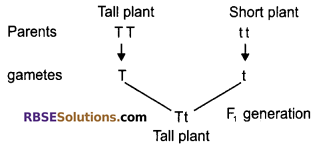
In the allele of F1 generation there are both traits viz. T (tall) and t (short) but the F1 generation is tall hence, it is the dominant character while t (short) is the recessive character.
Question 4:
The tall plant of the F1 generation with (RBSESolutions.com) allele, Tt is selfed. What is the outcome or ratio of the F2 progeny?
Answer:
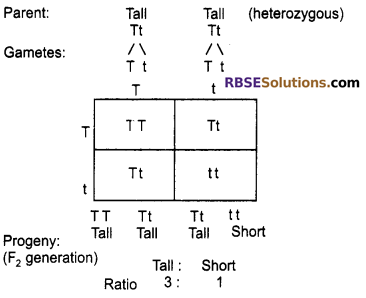
Question 5:
Define Genetics. What did Mendel’s (RBSESolutions.com) contributes to the genetics?
Answer:
The science of heredity and variation is called Genetics.
Mendel conducted breeding experiments in a plant called garden pea (pisum sativum) with contrasting pair of characters, found that only one character of the pairs appeared in the first generation but both the characters appeared in the subsequent generation. On the basis of these results of his experiments he put forth the various principals of inheritance. He also suggested that each character is controlled by a pair of factors which are now called as genes.
Question 6:
What is the difference between dominant and recessive traits?
Answer:
A dominant trait expresses itself in F1 generation but a recessive trait is not expressed in F1generation. Both dominant and recessive traits are expressed in F2 generation but percentage of progenies with recessive trait is always less.
Question 7:
Make a Punnette square to show a cross (RBSESolutions.com) between plants with yellow pod (Yy) and green pod (yy).
Answer:
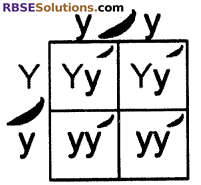
Class 10 Science Rajasthan Board Chapter 3 Genetics Long Answer Type Questions
Question 1:
(i) What is (RBSESolutions.com) genetics?
(ii) Give the common name of the plant on which Mendel performed its experiments.
(iii) What for did Mendel use the term factors and what are these factors called now?
(iv) Green and red coloured seeds are recessive and dominant trait respectively. Out of F1 and F2, in which generation will the green seed appear, if both parents are not hybrid.Green and red?
(v) What is monohybrid cross?
Answer:
(i) Science which deals with the study of heredity and variations is called genetic.
(ii) Pea plant.
(iii) Mendel used the term factors for ‘genes’.
(iv) F2 generation
(v) When inheritance of only one character is studied during hybridisation is a called monohybrid cross.
Question 2:
How do Mendel’s experiments show (RBSESolutions.com) that the (a) traits may be dominant or recessive, (b) traits are inherited independently.
Answer:
(a) When Mendel crossed pollinated pure tall pea plants with pure dwarf pea plants, only tall plants were obtained in F1 generation. On self pollinating the F1 progeny, both tall and dwarf plants appeared in F2 generation in the ratio 3 : 1. Appearance of tall character in both the F1 and F2 shows that it is a dominant character. The absence of dwarf character in F1 generation and its reappearance in F2 shows dwarfness is the recessive character.
(b) When Mendel conducted a dihybrid cross having two sets of characters, he obtained only one set of parental characters in F1 generation whereas in F2generation he obtained both the set of parental characters now recombined in the ratio of 9 : 3 : 3 : 1. The appearance of new recombinants in the F2 generation along with parental type shows that traits are inherited independently.
We hope the given RBSE Solutions for Class 10 Science Chapter 3 Genetics will help you. If you have any query regarding Rajasthan Board RBSE Class 10 Science Solutions Chapter 3 Genetics drop a comment below and we will get back to you at the earliest.